German National Police NCO/EM's Service Tunic
CATEGORY: Version
SKU: 52.GOR.02.01.01.03.001.000
Estimated market value:
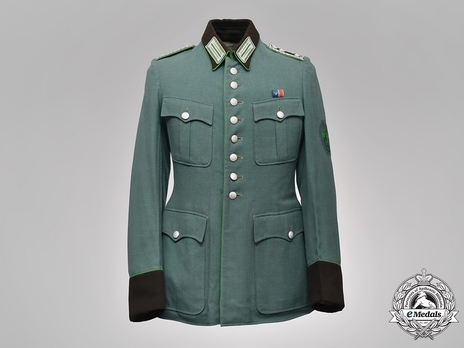
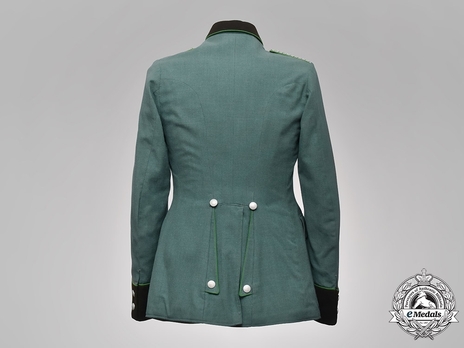
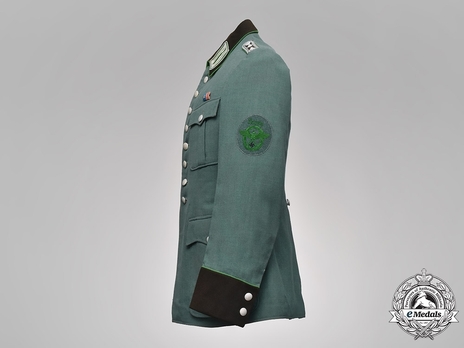
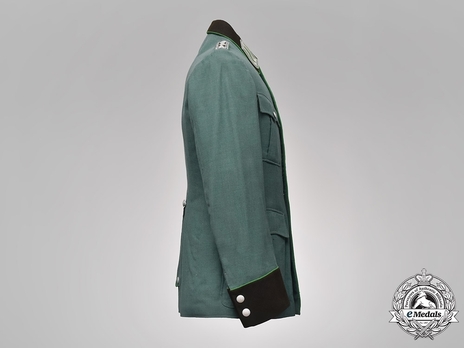
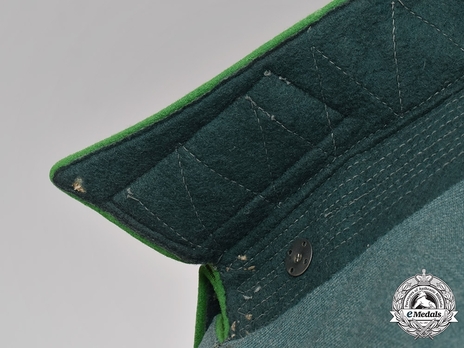
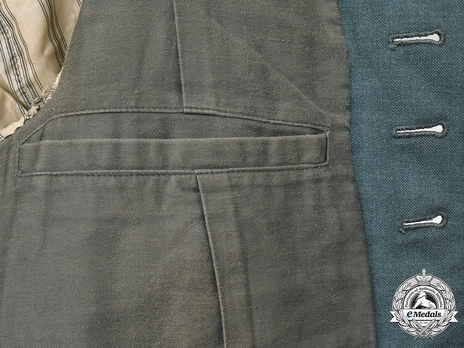
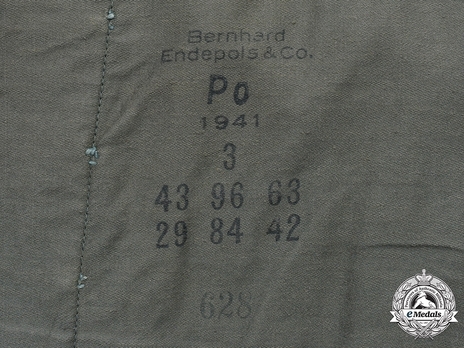
Estimated market value:
This is an extremely well-preserved Schutzpolizei (Municipal Police) Hauptwachtmeister tunic, constructed of smooth police green wool. The collar, constructed of brown wool, is neatly lined from end-to-end with woven green “Waffenfarbe” piping and is flanked on each side by insignia tabs. The latter are constructed of a green wool base trimmed by rolled and twisted silver aluminum bullion wire, bearing two silver bullion insignia with central green threaded bands. The shoulders are flanked by boards constructed of a green wool base, with cardboard reinforcement, with two rows of silver aluminum bullion wire bands at the outer edges, two rows of brown threaded bands in the middle, and two silvered bronze rank pips pinned through the top. The boards measure 34 mm (w) x 100 mm (l) and are secured to the tunic by a row of stitching at the outer end and by a pebbled, silvered zink button on the inside. The top left arm bears an insignia depicting a machine-embroidered green thread police-style German national eagle clutching a wreathed black mobile swastika within an oval oak leaf wreath, set on a grey wool background. Above the eagle, the patch bears the inscription “Leipzig” in green thread. The sleeve insignia measures 88 mm (w) x 97 mm (h). The front of the tunic has four pockets, with two on each breast, opening with stylized horizontal flaps with a reinforced buttonhole meeting a pebbled, silvered zink button. Pinned into the tunic above the top left breast pocket is a medal ribbon bar featuring four medals, including a Police 18-Year Long Service Medal and a Sudetenland Medal, set around a 30 mm-long magnetic medal bar with a horizontal pinback. The cuffs are constructed of black wool, rolled back to a depth of 100 mm and securely stitched across the circumference, trimmed by green piping. The tunic is closed with eight pebbled, silvered zink buttons on the right breast flap meeting an equal number of reinforced buttonholes on the left. The lower reverse of the tunic has a 290-mm vertical slit trimmed with green piping, with pebbled, silvered zink buttons at the bottom and belt hooks of identical construction at the top. The interior features a complete grey cotton twill liner, with the right breast flap stamped with a maker’s mark reading “Bernhard Endepols &. Co, 1941”, along with sizes “3, 43, 96,63, 29, 84, 42”. The sleeves are lined with rayon in a pinstripe design. There are two interior pockets, both on the left breast flap, one of which opens with a reinforced horizontal slit, while the other opens with a vertical slit. The interior of the collar features two magnetic metal hooks on the right meeting an equal number of eyelets on the right, as well as two butterfly-style magnetic metal clips. The tunic measures approximately 432 mm across the shoulders, with a total body length of 724 mm and an arm length of 612 mm. There is evidence that insignia have been removed from both shoulder boards, as well as some soiling of the wool, but the tunic is in an otherwise extremely fine condition.
During the Third Reich, an effort was made to unite all of Germany’s disparate provincial police forces and agencies into a single cohesive national unit. To attain this goal, Reichsführer-SS Heinrich Himmler was named Chief of the German Police in the Ministry of the Interior in June 1936. That same month, Himmler implemented new standardized uniforms, headgear, and insignia. The uniforms worn prior to Himmler’s appointment were often navy blue, particularly in what had been Prussia. The new uniforms were green, in a shade that was then dubbed “Police green”.
The German Police were divided into two main units, the Ordnungspolizei (Orps or Regular Police) and the Sicherheitspolizei (Secret Police); the Ordnungspolizei were unofficially called the green police (Grüne Polizei) as a result of their uniform colour. The Sicherheitspolizei were made up of two main organizations, the Gestapo and the Kriminalpolizei (Criminal Investigation Police). At the beginning of the Second World War, the Sicherheitspolizei were brought under the auspices of the Reich Main Security Office.
The Ordnungspolizei was also divided into smaller branches of service, and each branch was associated with a branch of service/troop colour (Truppenfarbe). The troop colours include:
Schutzpolizei des Reichs (National Protection Police): Green
Schutzpolizei der Gemeinden (Municipal Police) pre-1942: Red
Schutzpolizei der Gemeinden (Municipal Police) post-1942: Green
Gendarmerie (Gendarmes/Rural Police): Orange
Verwaltungspolizei (Administrative Personnel) pre-1942: Red over grey
Verwaltungspolizei (Administrative Personnel) post-1942: Light grey
Feuerschutzpolizei (Fire Protection Police): Carmine
Wasserschutzpolizei (Water Protection Police): Yellow
The uniform garments worn by members of the Wasserschutzpolizei (Water Protection Police) and the Feuerschutzpolizei (Fire Protection Police) remained blue after the 1936 uniform redesign.
The service tunics were worn by all ranks of German police personnel.
The buttons are silver-coloured (aluminum) and pebbled, with the exception of General ranks who wore gold-coloured buttons. There are generally eight buttons on the front closure (Generals only had six), two buttons on each sleeve cuff, and one button closing each pocket. There may also be four decorative buttons on the tunic's reverse vent. The vent is also lined in Truppenfarbe piping.
There are four exterior pockets in total on the tunic, with two at breast level and two at hip level. The pockets are generally “patch” pockets with scalloped flaps closed by one button each.
The collar and sleeve cuffs have an additional layer of brown wool, and for Officers and Non-Commissioned Officers/Enlisted Men (NCOs/EMs) they are lined in Truppenfarbe piping, same as the seam of the front closure.
The tunic may be lined with rayon, cotton, artificial silk, or silk, depending on the wearer's rank, as well as whether the tunic was manufactured privately. There are often interior pockets cut into the tunic's lining, and a manufacturer's label is often ink stamped or sewn onto tunic lining.
The insignia featured on these tunics include collar tabs, shoulder boards, and a sleeve eagle. See the relevant Insignia sections for more information.

Comments
Sign in to comment and reply.


Scroll Top